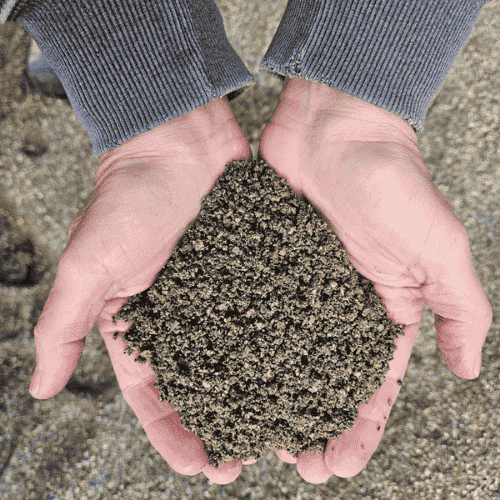
When planning a patio, walkway, or driveway using pavers, one of the most important questions homeowners and contractors ask is: “Should I use sand or gravel for the base?” While the top surface of your project may get all the attention, it’s what lies underneath that really determines long-term durability and appearance. At Kirk Allen Landscape Supply, we often get asked this question by our customers in New Jersey—and we’re here to help you make the right decision.
Why the Paver Base Matters
Before we get into which material is best, it’s important to understand the role of the paver base. Think of the base as the foundation of a house. If it’s unstable or poorly constructed, everything above it can shift, crack, or become uneven over time. A proper base:
- Supports the weight of foot or vehicle traffic
- Allows for drainage
- Minimizes shifting due to freeze-thaw cycles
- Helps prevent pavers from sinking or becoming uneven
Whether you’re working on a small backyard patio in Clinton, NJ or a full driveway renovation in Readington, the base you choose will determine the longevity of your investment.
What Is Gravel Base?
Gravel is a coarse aggregate material, usually composed of crushed stone. It’s commonly used for the deeper base layers in hardscaping projects. There are a few different types of gravel used in paver installations:
- Crushed Stone (¾” or ⅝”) – Ideal for creating a stable and compact base.
- Dense Grade Aggregate (DGA) – A mix of stone dust and crushed stone, which compacts very well.
- Recycled Concrete Aggregate – A cost-effective and eco-friendly alternative to traditional gravel.
Pros of Using Gravel:
- Excellent drainage: Water flows freely through the material, preventing pooling and erosion.
- Stable and strong: When properly compacted, gravel creates a rock-solid base that supports heavy loads.
- Prevents shifting: Gravel reduces the likelihood of paver movement, especially in larger areas.
Cons:
- More labor-intensive: Gravel needs to be spread in layers and compacted thoroughly.
- Dusty during installation: Stone dust and crushed stone can generate dust while being installed.
- Not ideal alone as a top layer: Needs to be topped with bedding material like sand.
What Is Sand Base?
Sand is typically used as a bedding layer between the compacted gravel base and the pavers. The most common types of sand used are:
- Concrete Sand: Coarse sand used to create a level surface.
- Polymeric Sand: A blend of sand and additives used between joints, hardens when wet.
Pros of Using Sand:
- Easy to level: Sand makes it easier to fine-tune the height and slope of pavers.
- Ideal for bedding layer: Sand fills small gaps and helps the pavers settle evenly.
- Affordable and accessible: Readily available and easy to work with.
Cons:
- Poor drainage: Compared to gravel, sand doesn’t allow water to drain as effectively.
- Prone to shifting: Without a gravel base, pavers laid directly on sand may move or settle unevenly.
- Not strong enough alone: Sand alone is not a suitable base for high-traffic or vehicle-load areas.
Should You Use Sand or Gravel?
The short answer: you should use both.
Ideal Base Construction:
- Excavate the Area: Remove 6–12 inches of soil depending on your project type.
- Lay Geotextile Fabric (optional): Helps prevent mixing of base with soil below.
- Install Gravel Base (4–8 inches): Compact in layers for strength and stability.
- Add Sand Layer (1 inch): Screed to level, then lay your pavers.
- Finish with Polymeric Sand: Fill paver joints for added stability and weed prevention.
This layered approach offers the best of both materials—gravel provides the stability and drainage, while sand ensures level placement of your pavers.
When Can You Use Sand Alone?
There are rare cases where sand may be sufficient on its own, such as:
- Small garden paths
- Temporary installations
- Light foot-traffic areas
However, even in these cases, the longevity and quality of the result are usually much better with at least a few inches of compacted gravel underneath.
How Much Gravel and Sand Do You Need?
Calculating how much base material you’ll need depends on your project size and depth of excavation. As a general rule:
- Gravel Base: 4–6 inches deep
- Sand Layer: 1 inch deep
Example:
For a 10 ft x 10 ft patio:
- Gravel: ~2.5 cubic yards
- Sand: ~0.5 cubic yards
Need help calculating the right amount for your project? The team at Kirk Allen Landscape Supply can help. Call us at 973-347-3117, and we’ll walk you through it.
Common Mistakes to Avoid
- Skipping the gravel base: This is the #1 mistake and causes uneven settling.
- Using fine sand: Concrete sand is better than play sand or beach sand, which compacts poorly.
- Not compacting in layers: Add gravel in 2-inch layers and compact each layer thoroughly.
- Poor drainage planning: Make sure your base slopes slightly away from your home.
Where to Buy Sand and Gravel in New Jersey
If you’re located in Clinton, Pittstown, Readington, or anywhere in Hunterdon County, NJ, Kirk Allen Landscape Supply is your local source for high-quality landscape materials.
We offer:
- Bulk gravel delivery
- Bedding sand and polymeric sand
- Crushed stone and DGA
- Expert advice and accurate quantity estimates
Final Thoughts
Choosing the right paver base isn’t just about convenience—it’s about building something that lasts. Gravel provides strength, drainage, and structure, while sand helps level and bed your pavers. For best results, use both.
If you’re working on a hardscaping project in New Jersey and need materials delivered fast and affordably, reach out to Kirk Allen Landscape Supply. We’re here to help homeowners and contractors alike build patios, driveways, and walkways that stand the test of time.
📞 Call us at 973-347-3117 or visit kirkallenlandscapesupply.com to place your order today.

